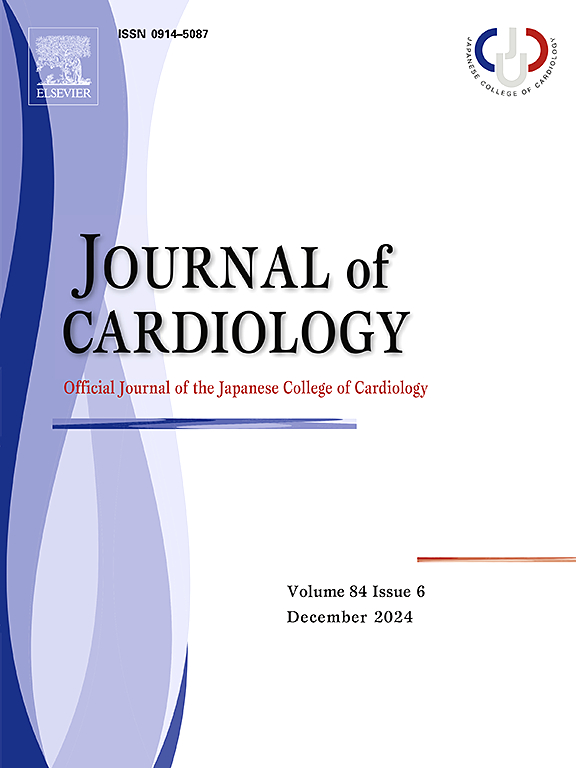Efficacy of sodium-glucose cotransporter 2 inhibitors on preventing atrial arrhythmia recurrences after atrial fibrillation ablation in patients with heart failure
IF 2.6
3区 医学
Q2 CARDIAC & CARDIOVASCULAR SYSTEMS
引用次数: 0
Abstract
Background
Atrial fibrillation (AF) is frequently observed in patients with heart failure (HF), and the efficacy of catheter ablation for AF treatment has been established; however, recurrence of atrial arrhythmia is possible. Sodium-glucose cotransporter 2 inhibitors (SGLT2i) have been reported to suppress AF recurrence in patients with diabetes; however, the efficacy of SGLT2i after AF ablation in patients with HF has not been fully elucidated.
Methods
A total of 141 consecutive patients with HF aged ≤75 years who underwent AF ablation were analyzed. Patients with follow-up shorter than six months were excluded. The primary endpoint was atrial arrhythmia recurrence after a 3-month blanking period. The type of recurrence, incidence of hospitalization for HF, and mortality rates were also evaluated.
Results
Forty-five patients used SGLT2i, and the median follow-up period was 372 days. The incidence of atrial arrhythmia recurrence was significantly lower in patients taking SGLT2i than in those that were not taking SGLT2i (20.0 % vs. 38.5 %, p = 0.029; log-rank test, p = 0.034). In the multivariate analysis, intake of SGLT2i was associated with a low risk of atrial arrhythmia recurrence (hazard ratio: 0.38, 95 % confidence interval: 0.18–0.80, p = 0.010). The rate of AF recurrence was significantly lower than the rate of atrial tachycardia/flutter recurrence in the SGLT2i group (44.4 % vs. 83.8 %; p = 0.013). The incidence of hospitalization for HF and/or death was low in both groups (0 % in the SGLT2i group and 1.0 % in the non-SGLT2i group). In 24 propensity score-matched pairs, the SGLT2i group had a lower recurrence rate (16.7 % vs. 45.8 %, p = 0.029, log-rank test, p = 0.047) than the non-SGLT2i group.
Conclusions
SGLT2i use in patients with HF was associated with a lower atrial arrhythmia recurrence after AF ablation; hence, SGLT2i administration for patients with HF who will undergo AF ablation may be beneficial.

钠-葡萄糖共转运蛋白2抑制剂预防心力衰竭患者房颤消融后房性心律失常复发的疗效
背景:心房颤动(AF)常见于心力衰竭(HF)患者,导管消融治疗AF的疗效已得到证实;然而,房性心律失常的复发是可能的。据报道,钠-葡萄糖共转运蛋白2抑制剂(SGLT2i)可抑制糖尿病患者的房颤复发;然而,SGLT2i在房颤消融后对HF患者的疗效尚未完全阐明。方法:对141例年龄≤75 岁连续行房颤消融治疗的HF患者进行分析。随访时间少于6个月的患者被排除在外。主要终点为3个月空白期后房性心律失常复发。对复发类型、心衰住院率和死亡率也进行了评估。结果:45例患者使用SGLT2i,中位随访时间为372 天。服用SGLT2i的患者心房心律失常复发率明显低于未服用SGLT2i的患者(20.0 % vs. 38.5 %,p = 0.029;Log-rank检验,p = 0.034)。在多因素分析中,SGLT2i的摄入与心房心律失常复发的低风险相关(风险比:0.38,95 %可信区间:0.18-0.80,p = 0.010)。SGLT2i组房颤复发率明显低于心房心动过速/扑动复发率(44.4% % vs. 83.8 %; = 0.013页)。两组患者因HF住院和/或死亡的发生率均较低(SGLT2i组为0 %,非SGLT2i组为1.0 %)。在24个倾向评分匹配对中,SGLT2i组的复发率低于非SGLT2i组(16.7 % vs. 45.8 %,p = 0.029,log-rank检验,p = 0.047)。结论:在HF患者中使用SGLT2i与房颤消融后较低的心房心律失常复发率相关;因此,对接受房颤消融的心衰患者给予SGLT2i治疗可能是有益的。
本文章由计算机程序翻译,如有差异,请以英文原文为准。
求助全文
约1分钟内获得全文
求助全文
来源期刊

Journal of cardiology
CARDIAC & CARDIOVASCULAR SYSTEMS-
CiteScore
4.90
自引率
8.00%
发文量
202
审稿时长
29 days
期刊介绍:
The official journal of the Japanese College of Cardiology is an international, English language, peer-reviewed journal publishing the latest findings in cardiovascular medicine. Journal of Cardiology (JC) aims to publish the highest-quality material covering original basic and clinical research on all aspects of cardiovascular disease. Topics covered include ischemic heart disease, cardiomyopathy, valvular heart disease, vascular disease, hypertension, arrhythmia, congenital heart disease, pharmacological and non-pharmacological treatment, new diagnostic techniques, and cardiovascular imaging. JC also publishes a selection of review articles, clinical trials, short communications, and important messages and letters to the editor.
 求助内容:
求助内容: 应助结果提醒方式:
应助结果提醒方式:


